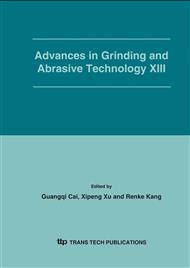p.48
p.52
p.57
p.62
p.66
p.71
p.76
p.81
p.85
A Study on the Methods for Precise Sorting of Synthetic Diamond Abrasives
Abstract:
In an abrasive tool the abrasive is the main part undertaking grinding work, thus, the grinding effects mainly depend on the types and properties of the abrasive. The strength and fracture property of the abrasive grain in a synthetic diamond abrasive tool have a direct influence on the operational performance of the tool. Generally, it is expected that the strength and protrusion height of the grain are as same as possible. The strength and fragmenting property of the abrasive grain hinge on its crystal shape and regularity and completeness, internal vice, impurity content and impurity distribution pattern. The abrasive grains must be sorted and classified to make their grain sizes and their properties consistent with each and all. In this paper, the author discusses the basic properties and related performances of synthetic diamond abrasives. Elementary discussion is made separately on improving the vibration sorting, introducing the magnetic separation, applying the heavy liquid separation, exploring the floatation technology and using the selective fragmentation principle. In addition, here are presented the basic methods for precise sorting of synthetic diamond abrasives and their general principles. Practices have proved these methods effective and feasible.
Info:
Periodical:
Pages:
66-70
Citation:
Online since:
February 2006
Authors:
Price:
Сopyright:
© 2006 Trans Tech Publications Ltd. All Rights Reserved
Share:
Citation:


